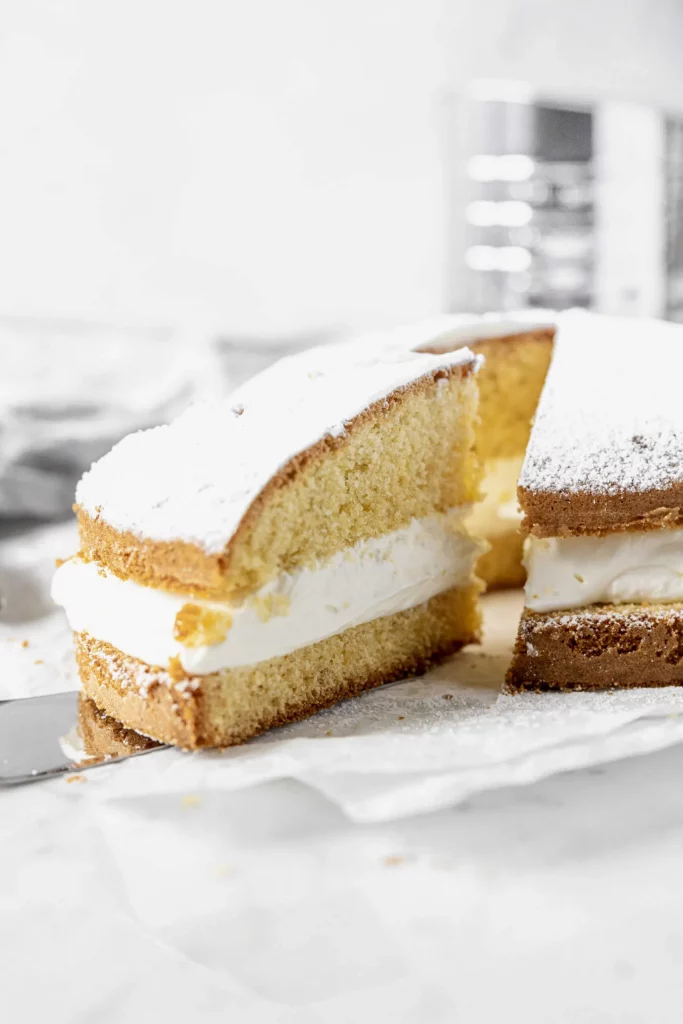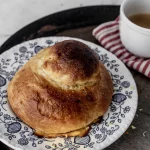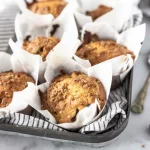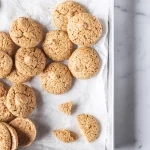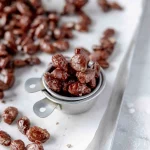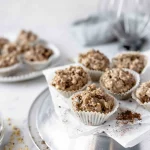Traditional, fluffy, easy, Margherita cake is always a certain success. Everyone can make it, even if they are not really good at cooking!
Soft Margherita cake wants only simple healthy ingredients: flour, sugar, milk, and eggs; lemon zest gives a tempting aromatic scent which balances the strong taste the eggs, the main ingredients of the recipe. It takes just little time to prepare: the truest pleasures come from simplicity.
Undoubtedly, it is considered one of the basics of the pastry-making art: a traditional, well-known cake you must have in your own cookery book: you must try it once, at least. Once made, I am sure, you will prepare it over and over again.
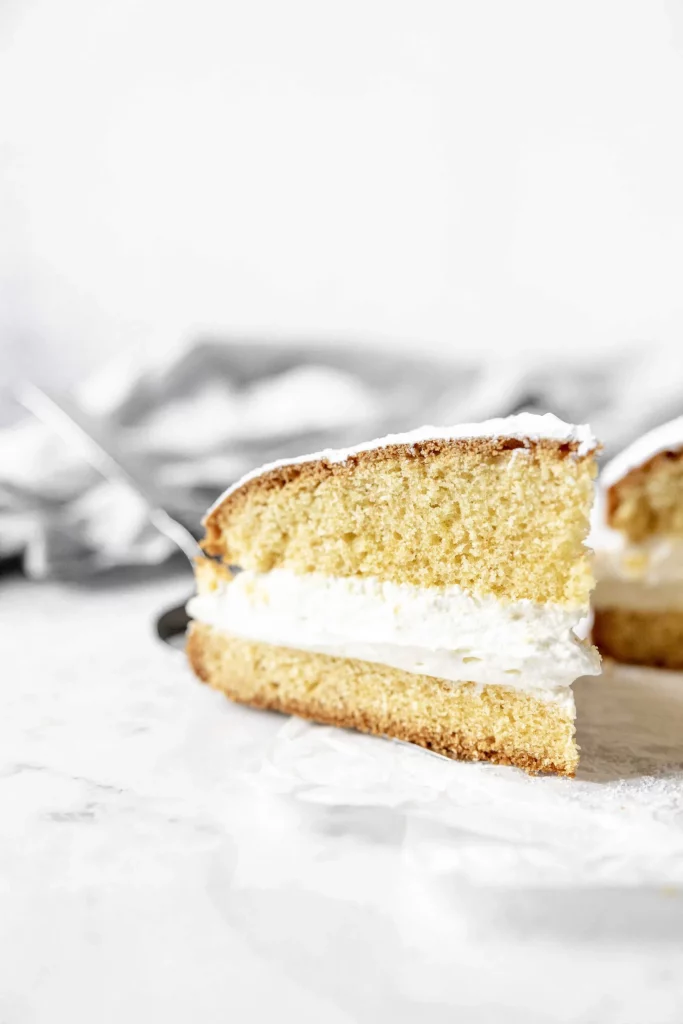
It is that kind of cake you can’t wait tasting. It reminds of childhood, when we stopped to play or run with our friends to have some rest and the snacks our grannies and mums had baked. Then we got back to our actives much stronger than before: we could go on playing until dinnertime.
On Sundays mornings, when everybody wanted to sleep late…but Margherita cake was waiting for us on the kitchen table-such a sweet effort!
It comes from Central or Northern Italy and it used to be baked on “special occasions”; it has undergone plenty of change: both the ingredients and the method have been modified over the years but it has also become a significant term of comparison of the most talented pastry-chefs who are always looking for the “fluffiest whipped batter”!
Why is it called Margherita?
Margherita cake is believed to be named after the bright yellow color of its batter and the generous white powdered sugar light coating, the colors of a daisy- margherita, in Italian. You will come upon it!
When can you eat margherita cake?
It makes either a perfect breakfast and afternoon snack both for adults and children or it may be stuffed with custard for a special occasion. Slice the cake horizontally and spread a generous layer of custard to your taste, chocolate spread, or my nice white milk cream. Dust it with plenty of powdered sugar.
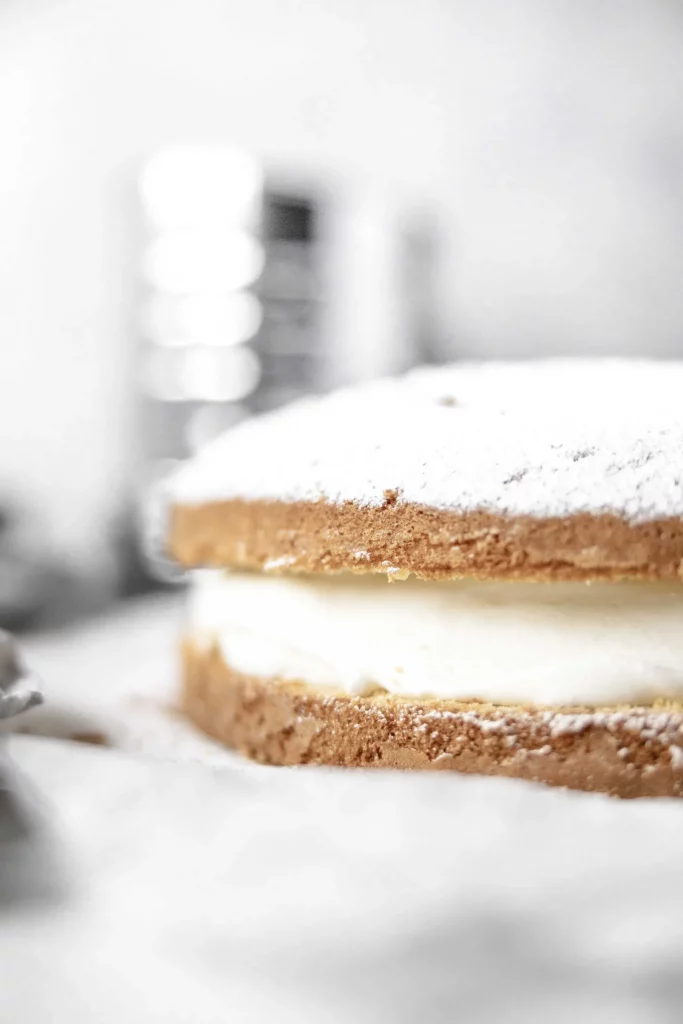
What is this cake like?
It is a high fluffy delicate taste; it looks like Italian sponge cake, but it much moister, because it is quite rich in butter. As every traditional recipes, you may encounter plenty of variations: with a lot of eggs, with or without potato flour,…even one with cocoa powder!
Here is shown my own recipe- I hope it will become yours, as well.
A few tricks before getting started…
- Temperatures do make the difference! All the ingredients must be at room temperare: eggs and butter are beaten more easily without clumps. If you add cold eggs to the mix of beaten sugar and butter, the temperature will drop sharply, and the mixture will be spoilt. If they are too cold, put them in a bowl with hot water for a few minutes- easy solution!
- Turn on the oven in good time-because it has to reach the required temperature and get stable at least 20 minutes before you put the batter into. Bake it in the center of the middle rack; if you place the batter on the upper rack, it will bake faster and the raising process will be more irregular; whereas in the lower rack the cooking is slower, and the cake will rise less;
- If you want a heavenly light cake, you have to carefully sift all the dry ingredients such as flour, baking powder, potato flour: they must get rich in air. Then, combine the dry ingredients with he moist ones (eggs, butter, sugar), a little at a time. Use the stand mixer at the lowest speed not to spoil what you have just beaten and to prevent the gluten in the flour from activating;
More tricks
- If you want your cake to be high, use a high-sided baking pan. You don’t have it? No problem, at all. Line the side of a regular baking pan with parchment paper;
- When the batter is ready, put it into the oven within 15 minutes; if you wait longer, the baking powder activates at room temperature; moreover the batter loses his fluffiness as the air incorporated while beating the eggs will be released;
- Don’t open the oven door in the first 20 minutes, not to spoil the rising process; A 20-24 cm (8-18 in) diameter round pan guarantees a more uniform baking process. If you have a bigger pan, slightly decrease the temperature and increase the cooking time by a few minutes; if the surface starts to get too golden, cover it with a tin foil;
- When you smell a tempting scent all around your kitchen, the cake is almost done. Check for its doneness. Stick a toothpick into the center of the cake, if it comes out clean your cake is done. It should be easily removed from the pan;
- If you carefully prepare the baking pan, no crack will appear on the surface: use a professional nonstick cooking spray, or generously butter the pan, sprinkle a spoon of flour and roteate the pan to spread it evenly; a sheet of parchment paper makes everything much easier;
- As soon as you take the cake out of the oven turn it upside down on a cooling rack or a plate; let it rest upside down for 10 minutes, and then remove it from the pan. The result? A perfect cylindrical fluffy cake.
Super fluffy Italian Margherita cake, with eggs, butter and a scent of lemon
Ingredients
- 150 gr flour type 00 or patent flour or pastry flour
- 130 gr potato flour (or corn starch)
- 3 whole eggs + 2 yolks
- 150 gr caster or powdered sugar
- 110 gr softened butter (or 90 ml of sunflower oil)
- 60 gr milk at room temperature
- 1 tbs vanillina flavoring
- organic lemon zest (extra)
- 14-16 gr baking powder
- 1 pinch salt
- powdered sugar to garnish
Instructions
- The butter must be at room temperature, so warm it in the microwave for a few seconds; it should keep its shape, but a finger should easily penetrate it;
- Beat the softened butter and the sugar in the stand mixer provided with the whisk attachment at low speed. If the butter gathers in the center of the whisk, switch the stand mixer off and remove the butter with a spatula, switch the mixer on again and increase its speed. Actually, this is not good, it means the butter is still too cold. You’d better wait some minutes longer- you will be able to combine the ingredients better;
- Add salt, baking powder, freshly grated lemon zest;
- Add vanilla flavoring and whisk at high speed until lightened and fluffy;
- Add the eggs one at a time and then the yolk with the mixer running;
- When the first eggs has been wholly incorporated, add the second, and go on until the last one;
- Make sure the eggs have been incorporated and then pour the milk (it must be at room temperature or lukewarm). Whisk until a smooth, thick, fluffy mixture.
- In another bowl mix flour, potato flour and baking powder; sift them twice onto a sheet of parchment paper;
- Stir the mix of flour into the egg compound a little at a time;
- If you use a stand mixer, decrease the speed and add all together;
- Increase to medium speed, stir until an even, compact batter. Switch off the mixer;
- If you don’t use a mixer, combine with downward motions as you don’t want a deflated batter;
- Carefully butter and flour a 20-24 cm (8-18 in) high sided baking pan; if you don’t have it, line the side of your ordinary baking pan with parchment paper to make the side higher; the paper will stick perfectly as you have generously buttered the pan. Your cake will get incredibly high and fluffy;
- Gently pour the batter into; smooth the top but don’t stir it, not to deflate it;
- Pre-heat the oven at 150°C (302°F) and bake for about 60-70 minutes. You might bake the cake at 180°C (356°F) for 50 minutes but a lower temperature favors the rising process;
- Check for its doneness. Stick a toothpick into the center of the cake, if it comes out clean your cake is done. The surface should be golden.
- Switch the oven off; let the cake rest with the half closed door for 5 minutes;
- Take it out of the oven and let the cake cool down on a cooling rack;
- When completely cool, (it takes about 2 hours) generously dust with powdered sugar.
What can you combine margherita cake with?
Do you want to make margherita cake even more tempting? Stuff it with your favorite custard, chocolate or vanilla custard, for instance. If you prefer something lighter, our for a lemon mousse: in a pan combine 90g of sugar, 350g of milk, the juice of a lemon, and a spoon of flour. Stir and cook en “bain Marie” until thick. Let it all down and then stuff your cake.
What about yogurt custard, whipped cream, jam,…you have plenty of choices: just set your imagination free. You may also top it with fruit, or glaze it as a big cupcake! Turn yourself into a cake designer and decorate it with sugar paste. This cake can be easily enriched to your taste!
So, plenty of options, hazelnut spread (you know Nutella, don’t you?) milk cream, traditional or chocolate custard, but keep in mind it must be completely cold before cutting it.
Try my milk cream: it super scrumptious!
Whip 500g of sweetened cream to very stiff peak, then fold in 100g of very cold condensed milk and two big spoon of multifloral honey (or acacia). Combine very gently with upward motions not to deflate the compound. A few minutes and your milk cream is ready!
I have an ace up my sleeve, are you ready for that?
First of all, put a steel mixing bowl, bastardella in Italian, into the freezer for over one hour. You need it to be absolutely cold to mix all the ingredients. In another bowl soften 5g of jelly in cold water. Melt 80g of white chocolate “en bain Marie” and then add 80g of pure hazelnut paste. Beat 80g of egg yolk with 40g of sugar until fluffy and lightened. Warm 200g of milk to 82° (180°F), here a kitchen thermometer would be very useful. Combine all the mixtures (eggs and milk, chocolate and hazelnut paste) and the well-squeezed jelly in the cold steel mixing bowl.
Then gently fold in 250g of whipped cream; be careful not to deflate the mixture. Refrigerate overnight and stuffed margherita cake.
How can you keep it?
Once cooled, wrap it in cling film, or keep margherita cake in a cake glass container up to 5-7 days. My granny used to put half peeled apple in the container with the cake. I don’t know how it works but it keeps the cake soft and fluffy. .
You may put margherita cake into a freezer bags and freeze it up to 1 month. Defrost at room temperature and have it in a couple of days.
When something goes wrong…if everything turned out right, there would be no fun!
Apparently, it is very easy, but when something goes wrong you feel disheartened. You can’t understand what mistake you have made! Although you have worked hard, the result is not what you have expected. Even if you can’t fix the damage … don’t give up. If you understand what the problem is, you will be able to avoid it next time.
Before blaming yourself or saying the recipe is wrong, let’s look into the question together.
Alas! The center of the cake has collapses and a kind of crater has formed
The center of the cake may irreparably collapse after the baking. This might have been provoked by a sudden change in temperature: did you open the oven door during the cooking while the cake was still raising? Secondly, you may have used too little flour to give the cake the right texture.
On the contrary, the cake may also inflate in the center: the oven temperature is too high. It means that the external part cooks too fast, and inside it is too moist and undercooked. A crispy layer forms on the surface which cracks when the batter rises, hence the cake collapses.
Nooooo: the cake deflates as soon as you take it out of the oven
You might have whipped too much air into the batter: the cake quickly inflates in the oven due to the heat, but it deflates as soon as you take it out of the oven. You may have taken your margherita cake out of the oven too early. Slightly open the door oven, and let the cake rest in for a few minutes.
Oh my dear! Is it going to blow up? When your cake looks like the top of a vulcano: the center has raised too much!
Differently from what has been told above, a kind of dome may raise in the center of the cake: it means too much flour in the batter. Check the recipe and use less flour next time.
That dome may be fixed: if you want to stuff the cake, turn it upside down. Then before stuffing it, slice it horizontally and cut the “dome” away.
The cake is has got the same texture of a dry sponge! When the cake is too dry!
If the cake is too dry, you may have cooked it too long, or the temperature was too high, and the natural moistness of the batter has evaporated. Or too much flour has been used (reduce the quantity next time).
It cracks, poor thing! When the surface gets crusty.
If the surface of the cake is too crusty and brown, you may have used too much sugar. Cut down on the quantity next time (at least two spoons less).
It looks as hard as a brick: the texture is too compact
The butter hasn’t been beaten enough. It might have been too softened, or melt, or too cold.
Focus on this step when you make the cake next time.

